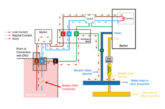
Natasha King, Product Manager at Vent-Axia, explains more about the requirements of the amended Approved Document Part F and how electricians can meet them.
Amended Approved Document Part F (Means of Ventilation) of the Building Regulations is seen as a vital step to improve indoor air quality (IAQ) as we head towards the Future Homes Standard on the road to net zero.
For electricians working in existing homes the amended document means that when carrying out energy efficiency measures to an existing dwelling they now need to assess if any extra ventilation is required to comply.
Amended Part F marked a ‘step change’ for ventilation when it was published in December 2021. Previously, ventilation had taken a back seat to the need for improved energy efficiency in our homes to meet carbon emission targets. As a result, we’ve all seen what happens when sealing up homes to make them more energy efficient without considering ventilation – increased indoor air pollution.
The most visible sign of this is condensation and mould, but this is only the tip of the iceberg since homes with indoor air pollution can contain over 900 chemical and biological contaminants in the air we breathe. Part F has therefore started to redress the balance of ventilation with energy efficiency with a focus on the importance of good IAQ to health and wellbeing.
Part F changes
What does this mean for electricians? A key addition to Approved Document F: Volume 1 for electricians is a new sub section ‘Installing Energy Efficiency Measures’ in existing properties. Here it sets out that:
“When carrying out energy efficiency measures to an existing dwelling, an assessment should determine what, if any, additional ventilation provision is needed, based on the estimated impact of the work.”
Part F provides two options for calculating these new ventilation requirements, the first is the simplified method which covers most properties, the second is seeking expert advice.
The simplified method involves counting the energy efficiency measures that have been added and then using Table 3.1 in Approved Document F: Volume 1 to classify whether they are minor or major. Homes are then allocated to Category A, B, or C depending on the number of minor and major measures, with A the lowest and C the highest. The category then determines what ventilation is required. Electricians should be aware that Category C natural ventilation does not comply with Part F without a full design by a competent person.
An important point to note here is electricians have to consider the energy efficiency measures that have been made since the home was built, as well as ones that are planned.
Since the UK has an ageing housing stock where many homes may have been fitted in the past with double glazing, insulation or had chimneys sealed up, it can be difficult to determine exactly how many energy efficiency measures may have been added to a dwelling. This could lead to an electrician inadvertently fitting intermittent ventilation in what they think is a Category B home but instead it is a Category C and, as a result, it will not provide sufficient ventilation to protect the occupants’ health, risking poor IAQ, condensation and mould.
Solutions
A simple solution to comply with Approved Document F: Volume 1 is for electricians to choose continuous ventilation for existing homes, since it is compliant with both category B and C and is the easiest and safest way of complying every time.
There are also huge benefits to moving to a continuous running ventilation system for customers since the fan will operate at a low speed, continuously maintaining good IAQ and if boost is required, it will be at a lower level compared to an intermittent fan. This means lower power consumption and noise levels.
Approved Document F gives detailed guidance on required levels of airflow needed by room and house size and should be followed when selecting a fan. There is a wide range of different types of continuous ventilation to choose from to ensure exactly the right solution.
For electricians aiming to help landlords tackle condensation and mould and improve IAQ, there are also continuous ventilation options aimed specifically at social housing, while another solution for deeper refurbishment of properties including habitable rooms, such as bedrooms and living areas, combines continuous ventilation with heat recovery.
Browse Vent-Axia’s product selector brochure online here











